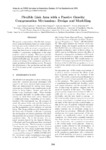Mostrar o rexistro simple do ítem
Flexible link arm with a passive gravity compensation mechanism: design and modeling
| dc.contributor.author | Cambera, Juan Carlos | |
| dc.contributor.author | Feliu-Talegon, Daniel | |
| dc.contributor.author | Gharab, Saddam | |
| dc.contributor.author | Feliu-Batlle, Vicente | |
| dc.date.accessioned | 2020-02-26T10:46:47Z | |
| dc.date.available | 2020-02-26T10:46:47Z | |
| dc.date.issued | 2018 | |
| dc.identifier.citation | Cambera, J.C., Feliu-Talegon, D., Gharab, S., Feliu-Batlle, V. Flexible link arm with a passive gravity compensation mechanism: design and modeling. En Actas de las XXXIX Jornadas de Automática, Badajoz, 5-7 de Septiembre de 2018 (pp.694-701). DOI capítulo: https://doi.org/10.17979/spudc.9788497497565.0694 DOI libro: https://doi.org/10.17979/spudc.9788497497565 | es_ES |
| dc.identifier.isbn | 978-84-09-04460-3 (UEX) | |
| dc.identifier.isbn | 978-84-9749-756-5 (UDC electrónico) | |
| dc.identifier.uri | http://hdl.handle.net/2183/25044 | |
| dc.description.abstract | [Abstract] The gravity compensation of flexible link manipulators using mechanisms based on counterweights has been previously studied in the research literature. However, as far as we are concerned, no attempt has been done to study the difficulties and benefits of constructing mechanisms for the same purposes based on springs. This paper presents a gravitational mechanism based on springs for a single-link flexible arm. In specific, we address the mechanical design of the mechanism and the dynamic modeling of the resulting system. To assess the effectiveness of the mechanism and the validity of the dynamic model, we present experimental results. | es_ES |
| dc.description.abstract | [Resumen] La compensación por gravedad de los manipuladores de enlace flexible que utilizan mecanismos basados en contrapesos se ha estudiado previamente en la literatura de investigación. Sin embargo, en lo que a nosotros respecta, no se ha hecho ningún intento de estudiar las dificultades y los beneficios de construir mecanismos para los mismos propósitos basados en resortes. Este artículo presenta un mecanismo gravitatorio basado en resortes para un brazo flexible de un solo enlace. En concreto, abordamos el diseño mecánico del mecanismo y el modelado dinámico del sistema resultante. Para evaluar la efectividad del mecanismo y la validez del modelo dinámico, presentamos resultados experimentales. | es_ES |
| dc.description.sponsorship | Ministerio de Economía y Competitividad; DPI2016-80547-R | es_ES |
| dc.language.iso | eng | es_ES |
| dc.publisher | Área de Ingeniería de Sistemas y Automática, Universidad de Extremadura | es_ES |
| dc.relation.hasversion | http://hdl.handle.net/10662/8575 | |
| dc.relation.uri | https://doi.org/10.17979/spudc.9788497497565.0694 | es_ES |
| dc.rights | Atribución-NoComercial 3.0 España | es_ES |
| dc.rights.uri | http://creativecommons.org/licenses/by-nc/3.0/es/ | * |
| dc.subject | Single-link flexible arm | es_ES |
| dc.subject | Gravitational mechanism | es_ES |
| dc.subject | Spring mechanisms | es_ES |
| dc.subject | Flexible link manipulators | es_ES |
| dc.title | Flexible link arm with a passive gravity compensation mechanism: design and modeling | es_ES |
| dc.type | info:eu-repo/semantics/conferenceObject | es_ES |
| dc.rights.access | info:eu-repo/semantics/openAccess | es_ES |
| UDC.startPage | 694 | es_ES |
| UDC.endPage | 701 | es_ES |
| dc.identifier.doi | https://doi.org/10.17979/spudc.9788497497565.0694 | |
| UDC.conferenceTitle | XXXIX Jornadas de Automática | es_ES |






